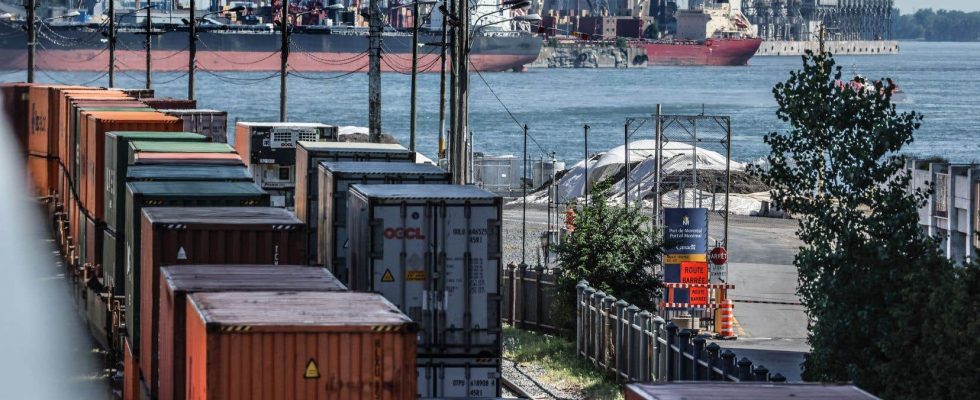The Port of Montreal has become an important hub for the export of stolen vehicles.
From mid-December to the end of March, police inspected around 400 containers there. She discovered nearly 600 vehicles reported stolen, the majority of them in the Toronto area.
According to law enforcement authorities, the port has become an important location for organized crime due to its strategic location and its large volume of large containers.
“It’s a very large port,” says Bryan Gast, vice-president, investigation department of the Équité Association, a national organization founded by insurance companies. The location, well connected by road and train to the greater Toronto area where many thefts have been reported, “is ideally located” for criminal gangs.
Mr. Gast explains that stolen vehicles are placed in containers in the Toronto area. They receive falsified documents, including customs declarations indicating their legitimacy, before being sent to the port by train or truck.
The large volume of goods passing through the Port of Montreal is exploited by organized crime. Last year, no less than 1.7 million containers were handled there, or about 1 million containers than the two largest ports on the east coast combined. According to port authorities, 70% of legal vehicle exports pass through there.
“ [Les voleurs] can sink their containers in the flow of legal transport of goods exported outside Canada,” says Mr. Gast.
For experts, problems of sharing of authority and a lack of personnel harm the repressive work of the police.
A spokesperson for the Port of Montreal, Renée Larouche, says that port authorities work closely with the police and the Border Services Agency, but points out that they can only open containers to save the life of a person or to prevent environmental disaster.
More than 800 police officers from several forces have an access card allowing them to enter the port. If they have warrants, they can open containers, says Mme Larouche. In areas controlled by the Border Services Agency, only its agents can search containers without obtaining a warrant.
Patrick Brown, the mayor of the city of Brampton, a city in the Peel region of Ontario, heavily affected by the scourge, says that the lack of container checks at the Port of Montreal is a delight for criminals.
According to him, the problem of vehicle theft is greater in Canada than in the United States because customs authorities have equipment allowing them to check a greater percentage of containers.
“Organized crime refuses to take risks in the United States,” he says. In Canada, we examine less than one percent of containers. »
Mr. Brown wants the $28 million recently announced by the federal government for the Canada Border Services Agency to be used to immediately purchase scanners for the Port of Montreal and two marshalling yards in the Toronto region. He adds that police should be able to enter customs-controlled areas without obtaining a warrant or permission from the Border Services Agency.
“People who have GPS on their vehicle can trace it to the rail yard or the port, but the local police can’t do anything about it. »
Since the start of the year, the Canada Border Services Agency has seized 300 vehicles stolen from rail yards in the Toronto area. In 2023, it had recovered 1,200 vehicles stolen from the port of Montreal.
The agency declines to reveal the percentage of containers that are checked each year. Annie Beauséjour, the regional director for Quebec, says that all containers reported by the police are inspected by customs officials.
“We would like to be able to check all containers leaving the country, but unfortunately this is not realistic,” says Mme Beausejour. She adds that the agency cannot slow down the flow of goods either.
According to the union representing customs officers, the lack of people is obvious in the port of Montreal. In February, testifying before the standing committee on security, President Mark Weber reported the presence of only eight customs agents at the Port of Montreal. He also deplored the lack of space. “When we find six stolen vehicles, sometimes we have to wait days for someone to come and collect them so we can inspect others,” he said.
The lack of resources at the Port of Montreal is typical of other port facilities worldwide, underlines Anna Sergi, a criminologist from the University of Essex in the United Kingdom.
“ [Les agences douanières] focus their attention on imports. Nobody takes care of exports. We don’t invest in exports because they are someone else’s problem. The only country that invests a little, but only a little, in audits of exported products is the United States. »
The underworld has long been present on the coast of Montreal, says Professor Sergi. The West Gang and the mafia have long been involved in drug importation by bribing customs officials and dock workers.
Inspector Dominique Côté, of the Montreal Police Service, says that the force has no information allowing it to believe that the port of Montreal is infiltrated by organized crime and that this would be the reason why there are many stolen vehicles.
